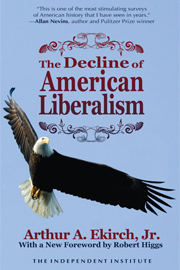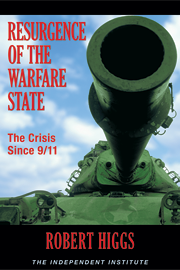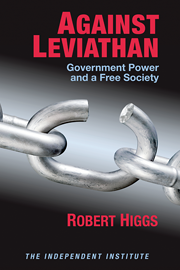Despite the astonishing flood of more than a trillion dollars in new commercial-bank reserves that the Fed created in late 2008 and early 2009, when it undertook to rescue the big banks and other institutions from the consequences of their boom-time mistakes, Ben Bernanke has insisted that the Fed can and will contain this inflationary potential, and he has emphasized that inflation remains under control, indeed, that potential deflation presents the greater danger. He rests his case on the evidence of standard macroeconomic indexes.
Standard measures of the money stock, for example, have not increased greatly. The year-to-year change (ending in January 2011) in M2 was only 4.3 percent; the two-year change, only 6.4 percent. For MZM (money zero maturity), the corresponding rates of change were 2.6 percent and 4.4 percent, respectively. Thus, it would appear that by historical standards money has grown quite moderately in the past two years.
Bernanke and his supporting cast of monetary economists can also point to corroborating evidence that by historical standards the rate of inflation has been modest. The year-to-year change (ending in January 2011) in the all-items consumer price index (CPI) was only 1.7 percent; the two-year change, only 4.3 percent. The implicit price deflator for GDP, the broadest of all price indexes, reveals even less inflation. This index, which is computed on a quarterly basis, shows a one-year change of only 1.4 percent for the year ending in the fourth quarter of 2010, and a corresponding two-year change of only 1.8 percent.
(I have computed all of the figures mentioned in this article from basic data available at the website maintained by the Federal Reserve Bank of St. Louis.)
The foregoing variables are the ones that macroeconomists and monetary analysts at the Fed consult most often in their analysis of the economy’s performance and of the relation between money and inflation. So, if Bernanke tells us that inflation is not a problem, he is clearly resting his case on the kinds of evidence that the country’s recognized experts in the great universities view as scientifically de rigueur.
A serious problem lurks, however, in the way the mainstream experts think about the economy, and hence in the kind of analysis they undertake to assess its current performance and its likely future changes. All too often, they model the macroeconomy as a black box into which flow undifferentiated “labor” services and “capital” services and out of which flows a uniform substance called “output,” measured empirically by estimates of real GDP. Units of this output command a price known as the “price level,” measured empirically by the GDP deflator; otherwise, prices play no role in the model. The interest rate plays only a limited role as a determinant of the demand for money and as a minor determinant of saving and investment spending. Time is essentially irrelevant. There is no time structure of production in which certain kinds of production must precede others in a process running from raw materials to intermediate goods to completed consumer goods because, as mentioned, such distinctions among different kinds of goods are ignored in favor of positing a single homogeneous “output.” Just as time plays no role, and hence the interest rate (the price of goods available now relative to goods available later) plays no role in resource allocation, so location does not matter. It’s as though all production took place at a Euclidean point, and therefore no one need worry about, say, the government’s injecting “stimulus” money into Connecticut in order to lower unemployment in Nevada.
Although modern macroeconomic models, which have been constructed since the 1930s, vary in many ways, and some of them do not conform to the foregoing description in one way or another, the general approach of macroeconomic analysis fits my description all too well. It is a mode in analysis in which the time structure of production is ignored, interest rates play little or no role in allocating resources between time periods, a single output is produced, and inputs are viewed as homogeneous in kind, quality, and location. If one suspects that such extreme simplification may be squeezing every feature of the Prince of Denmark out of Hamlet, one’s instincts are alive and well.
Because this approach to thinking about the macroeconomy is essentially timeless―inputs flow in and outputs flow out simultaneously during any arbitrarily defined period of time―the Fed’s scrutiny of the economy’s performance tends to be extraordinarily focused on the recent past (from which its most up-to-date data come) and the near-term future. Truly long-run considerations scarcely come into play, as the Fed attempts to fine tune its policy instruments at monthly or more frequent intervals to keep the economy on a smooth growth path with a low rate of inflation and a low rate of unemployment―in truth, an impossible task even if performed with the greatest competence, because the number of targets exceeds the number of instruments. So, Bernanke is always referring to the most recent report on inflation, for example, to demonstrate that the Fed has taken the optimal policy stance; and he always assures us that whenever new data reveal a deviation from the desired economic conditions, the Fed will take appropriate steps to correct its misbehavior.
Such myopic monetary policy making has great potential for creating too much monetary stimulus in certain periods, then overreacting by creating too much monetary contraction, thereby introducing or amplifying fluctuations in the economy’s real growth or its rate of inflation that would not occur if the Fed did not exist. As Roger Garrison observes, the Fed is a loose cannon on the economy’s deck, rolling with great momentum here and there as the ship pitches and rolls and wreaking havoc as it crashes into everything in its compass. Bernanke claims to have absorbed Milton Friedman’s teachings about the Fed’s responsibility for causing the Great Depression, but he evidently skipped Friedman’s class on the day that the professor told the pupils that monetary policy exerts its effects with long and variable lags. Because of these unpredictable lags, the Fed is always, as it were, reacting to information that does not tell the full story about how the economy is already responding, or eventually will respond, to monetary policy changes that extend for a year or more into the past.
One error the Fed makes time and again is failure to recognize until it is too late that it has already built inflation into the system. So, we might well wonder whether the Fed is making that very error now. Several indicators suggest strongly that it is doing so.
Inflation does not usually appear equally throughout the economy. Instead, it usually begins in the markets for raw materials and intermediate goods and then works its way to consumer-goods markets, where retailers always explain to irate buyers that they are raising prices only because their cost of goods has risen. If such inflation is occurring now, we can identify it by checking the producer price index (PPI) and some of its components.
Looking first at the overall PPI, we find that the year-to-year change (ending in January 2011) was 5.7 percent, or 4 percentage points greater than the change in the CPI; the two-year change was 12.3 percent, or 8 percentage points greater than the change in the CPI.
Some important components of the PPI have risen even faster. For the PPI for crude foodstuffs and feedstuffs, the one-year change was 20.6 percent, the two-year change, 25.6 percent. The PPI for fuels and power shows a one-year change of 6.5 percent and a two-year change of 33.1 percent. Because food, feed, fuel, and power are so critical to many of the world’s poorer countries, these rapid increases in prices have already provoked riots and other displays of desperation throughout the world. It is reasonable to assume that before long the price increases in these markets will have an effect on the rate of increase in consumer-goods prices in the United States and other advanced economies.
We may also look for price changes that reflect market participants’ expectation of future inflation and hence their attempts to purchase real goods that might serve them as hedges against such price acceleration. Here the most notable indicators include, of course, the price of gold. For the closing gold price in January 2011, the one-year increase was 24.0 percent, the two-year increase, 44.3 percent. Other such indicators come from the stock market, where traders bid up share prices in the expectation of future net income to be earned from the firms’ sales of real goods and services. For the Standard & Poor’s 500 index, the one year increase (ending in January 2011) was 19.8 percent, the two-year increase, 55.7 percent.
Bernanke dismisses evidence such as the foregoing by noting, correctly, that the prices of producer goods typically vary more than the prices of consumer goods. In his view, one only muddies the waters of one’s analysis of inflation by taking note of producer prices. He might similarly dismiss the zooming prices of gold and corporate stocks as the product of forces unrelated to monetary policy―which they might be, of course, but in the present case I do not think they are.
Bernanke is a celebrated mainstream macroeconomist. His achievements in this field account for his having become Fed chairman in the first place. But this background, training, and research have predisposed him, as it has predisposed almost all mainstream macro and monetary economists, to think about the macroeconomy and about the relation between money and inflation in a way that hides essential elements of what is actually occurring. The root of all of these evils is excessive aggregation. The reigning macroeconomic analysis also has other important flaws, as I have suggested, but however these other problems might be dealt with, as long as mainstream analysts continue to work within the confines of such highly aggregated models, continued failures to understand and control the economy’s movements are well-nigh inevitable.



















